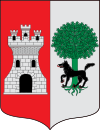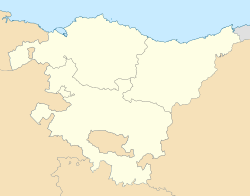Alonsotegi facts for kids
Quick facts for kids
Alonsotegi
|
||
|---|---|---|
 |
||
|
||
| Country | ||
| Autonomous community | ||
| Province | Biscay | |
| Comarca | Greater Bilbao | |
| Area | ||
| • Total | 21 km2 (8 sq mi) | |
| Population
(2018)
|
||
| • Total | 2,903 | |
| • Density | 138/km2 (358/sq mi) | |
| Demonym(s) | Basque: alonsotegiarra | |
| Time zone | UTC+1 (CET) | |
| • Summer (DST) | UTC+2 (CEST) | |
| Postal code |
48810
|
|
Alonsotegi (which is Alonsotegui in Spanish) is a small town, or municipality, located in the province of Biscay. This area is part of the Basque Country in Spain. For a long time, Alonsotegi was part of the nearby town of Barakaldo. But in the late 1800s, it became its own independent town.
Alonsotegi is about 8 kilometers (5 miles) from the big city of Bilbao. It sits in the valley of the Cadagua River, with a highway (BI-636) running through it. The town covers an area of 21 square kilometers (about 8 square miles). Around 2,900 people live here, spread across three main areas: Alonsotegi (the main part), Iráuregui, and Arbuyo.
Contents
Exploring Alonsotegi's Geography
Alonsotegi covers a total area of 21 square kilometers. A lot of the town's businesses and people are found in the valley created by the Cadagua River. This valley is nestled between the Sierra Sasiburu mountains (which are about 500 meters high) and the taller Ganekogorta (998 meters) and Pagasarri (673 meters) mountains.
Many small rivers start in these mountains. They flow down the slopes and join the Cadagua River. The main part of Alonsotegi is located at an altitude of 32 meters (about 105 feet) above sea level. Alonsotegi shares its borders with several other towns. To the north, it borders Barakaldo and Bilbao. To the south, you'll find Arrankudiaga and Güeñes. To the east, it borders Arrigorriaga and Bilbao again, and to the west, it borders Güeñes.
A Look at Alonsotegi's History
Alonsotegi's history is quite interesting, even though it wasn't mentioned in any old documents before the year 1300. Its story can be divided into four main time periods.
- Early Days (Before the 1500s): For a long time, Alonsotegi was part of the Arrigorriaga municipality. The San Antolín church, which is the oldest building in Alonsotegi, was built during the 1400s.
- Becoming Independent (1500s to 1888): In the 1500s, Alonsotegi became its own independent town. This lasted until 1888. The San Bartolomé parish church was built in the 1500s. It became separate from its original church, the Santa María Magdalena Church in Arrigorriaga, because the two places were quite far apart. In 1647, Alonsotegi and Arrigorriaga signed an agreement. This agreement decided things like how they would share pastures and meadows, and how their local governments would work. Later, in 1777, another agreement was made between Bilbao and Alonsotegi and Arrigorriaga. This one was about a new ice house built in the Ganekogorta mountains. By the 1800s, wars made it very hard for Alonsotegi to manage its money. Because of this, Alonsotegi decided to join the Baracaldo municipality in 1888.
- Part of Barakaldo (1888 to 1990): From November 13, 1888, until December 31, 1990, Alonsotegi was part of the Baracaldo municipality. During this time, new schools were built in 1903, and a new San Bartolomé Church was built in 1904. A sad event happened on January 20, 1980, known as the Alonsotegi bombing. A bomb exploded in a local bar, causing harm to people.
- A New Beginning (1991 Onwards): January 1, 1991, marked a new chapter for Alonsotegi. It officially became its own separate municipality again, along with the Iráuregui district.
Discovering Alonsotegi's Attractions
Alonsotegi is surrounded by beautiful scenery and has many interesting places to explore. There are short hiking trails that lead through the town's most attractive spots and to natural wonders like the Ganekogorta and Sasiburu mountain ranges.
The area is full of things to see, both made by people and found in nature. You can find old mines, ice houses, and historic workers' homes. In nature, there are mineral deposits, lovely oak groves, beech forests, green meadows, and even wild boars and roe deer.
Alonsotegi has several places that are important for their history, culture, and natural beauty:
- Pagasarri's ice houses, which were used to store ice long ago.
- The Vizcaya Bridge, a famous transporter bridge nearby.
- Old chapels like San Antolín de Iráuregui, San Martín, Santa Quiteria, and Nuestra Señora de la Guía Hermitages.
- Buildings with a special style called Neobasque architecture, like the Barrankalea working houses.
- The San Bartolomé Church, built in the Neo-Gothic architecture style.
- Traditional farm buildings like the stables and pens in Artiba's pastoral district.
Local Elections in 2011
In the municipal elections held in 2011, six different political groups put forward candidates. These were EAJ-PNV, Bildu, PSE-EE, PP, EB, and an independent group called Alonsotegiko Ezkerra. Here's how the votes turned out:
| Political Party | Number of votes | % valid votes for candidates | Town councillor(s) |
|---|---|---|---|
| Basque Nationalist Party (EAJ-PNV) | 708 | 41.55% | 5 |
| Bildu (Bildu) | 500 | 29.34% | 4 |
| Alonsotegiko Ezkerra (AE) | 194 | 11.38% | 1 |
| Basque Country's Socialist Party – Euskadiko Ezkerra (PSE-EE) | 173 | 10.15% | 1 |
| Partido Popular (PP) | 68 | 3.99% | 0 |
| Ezker Batua (EB) | 30 | 1.76% | 0 |
After these elections, Aitor Santiesteban Aldama was chosen as the new mayor of Alonsotegi.
Famous People from Alonsotegi
Alonsotegi has been home to several notable individuals:
- Fray Martin de Coscojales, a monk.
- Fray Miguel de Alonsotegui and Miranda and Jose Zabala, who were also friars.
- Iñigo Urkullu, a well-known politician.
- Andoni Goikoetxea, a former professional football player and coach.
- Marcelino Bilbao Bilbao, who was a Lieutenant in the Isaac battalion and a survivor of the Nazi concentration camp Mauthausen.
Images for kids
See also
 In Spanish: Alonsótegui para niños
In Spanish: Alonsótegui para niños






